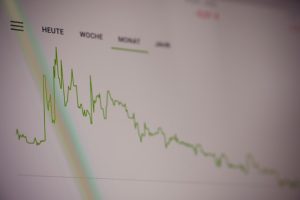Forex, or foreign exchange, is the largest financial market in the world, with an estimated daily turnover of $5.3 trillion. It is a decentralized market where currencies are bought and sold 24 hours a day, five days a week. The forex market is highly volatile, and the prices of currencies can fluctuate rapidly. To understand the forex market, it is important to understand the percent rate of change.
The percent rate of change, also known as the percentage change, is the difference between the current price of a currency and its previous price, expressed as a percentage. It is a measure of the rate at which the price of a currency is changing over time. The percent rate of change is calculated using the following formula:
Percent Rate of Change = ((Current Price – Previous Price) / Previous Price) x 100
For example, if the price of the EUR/USD currency pair was 1.1000 yesterday and it is 1.1200 today, the percent rate of change would be:
((1.1200 – 1.1000) / 1.1000) x 100 = 1.82%
This means that the price of the EUR/USD currency pair has increased by 1.82% over the past day.
The percent rate of change is an important metric for forex traders as it helps them to identify trends in the market. If the percent rate of change is positive, it means that the price of a currency is increasing, while a negative percent rate of change indicates that the price is decreasing. A high percent rate of change indicates that the price is changing rapidly, while a low percent rate of change indicates that the price is changing slowly.
Traders use the percent rate of change to identify potential trading opportunities. If the percent rate of change is positive, traders may look to buy the currency in the hope that the price will continue to rise. Conversely, if the percent rate of change is negative, traders may look to sell the currency in the hope that the price will continue to fall.
The percent rate of change is based on a number of factors, including economic indicators, political events, and market sentiment. Economic indicators, such as GDP, inflation, and employment data, can have a significant impact on the value of a currency. Positive economic data can increase the demand for a currency, while negative economic data can decrease demand.
Political events, such as elections and geopolitical tensions, can also affect the value of a currency. For example, if a country is experiencing political instability, investors may be less willing to invest in that country, which could lead to a decrease in the value of its currency.
Market sentiment, or the overall mood of traders, can also impact the percent rate of change. If traders are optimistic about the future of a currency, they may be more willing to buy, which could lead to an increase in the percent rate of change. Conversely, if traders are pessimistic, they may be more willing to sell, which could lead to a decrease in the percent rate of change.
In conclusion, the percent rate of change is an important metric for forex traders as it helps them to identify trends in the market. It is based on a number of factors, including economic indicators, political events, and market sentiment. Traders use the percent rate of change to identify potential trading opportunities, and a high percent rate of change can indicate a rapidly changing market. Understanding the percent rate of change is essential for anyone looking to trade forex.





